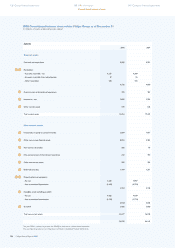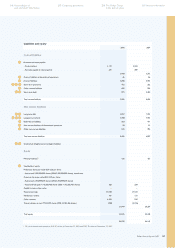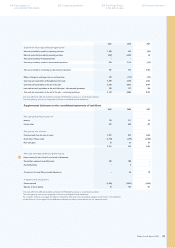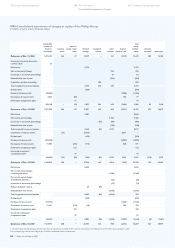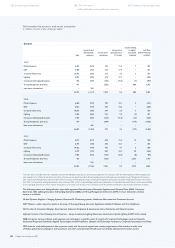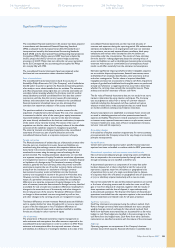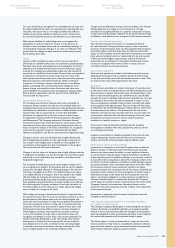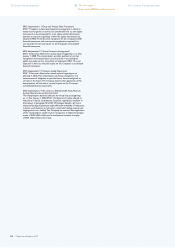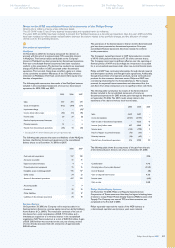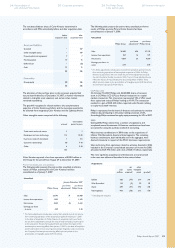Philips 2007 Annual Report Download - page 200
Download and view the complete annual report
Please find page 200 of the 2007 Philips annual report below. You can navigate through the pages in the report by either clicking on the pages listed below, or by using the keyword search tool below to find specific information within the annual report.
Philips Annual Report 2007206
evaluated regularly by the chief operating decision maker or the Board
of Management of the Company. The Board of Management decides
how to allocate resources and assesses performance. The Company
determined that reportable segments are the same as the operating
segments. Reportable segments comprise of the Company’s business
sectors: Medical Systems, Domestic Appliances and Personal Care,
Consumer Electronics, Lighting, Innovation & Emerging Businesses, and
Group Management & Services. The sectors are organized based
on the type of products produced and nature of markets served.
Segment accounting policies are the same as the accounting policies
as described in this note.
Earnings per share
The Company presents basic and diluted earnings per share (EPS)
data for its common shares. Basic EPS is calculated by dividing the net
income attributable to shareholders of the Company by the weighted
average number of common shares outstanding during the period.
Diluted EPS is determined by adjusting the prot or loss attributable
to shareholders and the weighted average number of common shares
outstanding for the effects of all dilutive potential common shares,
which comprise convertible personnel debentures, restricted shares
and share options granted to employees.
Revenue recognition
Revenue for sale of goods is recognized when the signicant risks
and rewards of ownership have been transferred to the buyer,
recovery of the consideration is probable, the associated the costs
and possible return of the goods can be estimated reliably, there is
no continuing involvement with goods, and the amount of revenue
can be measured reliably.
Transfer of risks and rewards varies depending on the individual terms
of the contract of sale. For consumer-type products in the segments
Lighting, DAP and Consumer Electronics, these criteria are generally
met at the time the product is shipped and delivered to the customer
and, depending on the delivery conditions, title and risk have passed
to the customer and acceptance of the product, when contractually
required, has been obtained, or, in cases where such acceptance is not
contractually required, when management has established that all
aforementioned conditions for revenue recognition have been met.
Examples of the above-mentioned delivery conditions are ‘Free on
Board point of delivery’ and ‘Costs, Insurance Paid point of delivery’,
where the point of delivery may be the shipping warehouse or any
other point of destination as agreed in the contract with the customer
and where title and risk in the goods pass to the customer.
Revenues of transactions that have separately identiable components
are recognized based on their relative fair values. These transactions
mainly occur in the Medical Systems segment for arrangements that
require subsequent installation and training activities in order to become
operable for the customer. However, since payment for the equipment
is typically contingent upon the completion of the installation process,
revenue recognition is deferred until the installation has been completed
and the product is ready to be used by the customer in the way
contractually agreed.
Revenues are recorded net of sales taxes, customer discounts, rebates
and similar charges. For products for which a right of return exists
during a dened period, revenue recognition is determined based
on the historical pattern of actual returns, or in cases where such
information is not available, revenue recognition is postponed until
the return period has lapsed. Return policies are typically based
on customary return arrangements in local markets.
For products for which a residual value guarantee has been granted
or a buy-back arrangement has been concluded, revenue recognition
takes place in accordance with the requirements for lease accounting
of IAS 17 Leases. Shipping and handling costs billed to customers are
recognized as revenues. Expenses incurred for shipping and handling
costs of internal movements of goods are recorded as cost of sales.
Shipping and handling costs related to sales to third parties are
recorded as selling expenses and disclosed separately. Service revenue
related to repair and maintenance activities for goods sold is recognized
ratably over the service period or as services are rendered.
A provision for product warranty is made at the time of revenue
recognition and reects the estimated costs of replacement and
free-of-charge services that will be incurred by the Company with
respect to the products. The customer has the option to purchase such
an extension, which is subsequently billed to the customer. Revenue
recognition occurs on a straight-line basis over the contract period.
Royalty income, which is generally earned based upon a percentage
of sales or a xed amount per product sold, is recognized on an
accrual basis.
Government grants are recognized as income as qualied
expenditures are made, except for grants relating to purchases
of assets, which are deducted from the cost of the assets.
Employee Benet Accounting
The liability recognized in the balance sheet in respect of dened
benet pension plans is the present value of the dened benet
obligation at the balance sheet date less the fair value of plan assets,
together with adjustments for unrecognized actuarial gains and losses
and unrecognized past service costs. The dened benet obligation
is calculated annually by a qualied actuary using the projected unit
credit method. Recognized prepaid assets are limited to the net total
of any unrecognized actuarial losses and past service costs and the
present value of any future refunds from the plan or reductions in
future contributions to the plan.
Pension costs in respect of dened-benet pension plans primarily
represent the increase of the actuarial present value of the obligation
for pension benets based on employee service during the year and
the interest on this obligation in respect of employee service in
previous years, net of the expected return on plan assets.
Actuarial gains and losses arise mainly from changes in actuarial
assumptions and differences between actuarial assumptions and what
has actually occurred. They are recognized in the income statement,
divided over the next 5 years, only to the extent that their net
cumulative amount exceeds 10% of the greater of the present value
of the obligation or of the fair value of plan assets at the end of the
previous year (the corridor).
To the extent that pension benets vest immediately following the
introduction of a change to a dened-benet plan, the resulting past
service costs are recognized immediately.
Obligations for contributions to dened-contribution pension plans
are recognized as an expense in the income statement as incurred.
In certain countries, the Company also provides postretirement
benets other than pensions. The costs relating to such plans consist
primarily of the present value of the benets attributed on an equal
basis to each year of service, interest cost on the accumulated
postretirement benet obligation, which is a discounted amount,
and amortization of the unrecognized transition obligation.
Share-based payment
The Company recognizes the estimated fair value, measured as of
grant date of equity instruments granted to employees as compensation
expense over the vesting period on a straight-line basis, taking into
account expected forfeitures. The Company uses the Black-Scholes
option-pricing model to determine the fair value of the equity instruments.
The fair value of the amount payable to employees in respect of share
appreciation rights, which are settled in cash, is recognized as an expense,
with a corresponding increase in liabilities, over the vesting period.
The liability is remeasured at each reporting date and at settlement
date. Any changes in fair value of the liability are recognized as
personnel expense in the income statement.
Income tax
Income tax comprises current and deferred tax. Income tax is
recognized in the income statement except to the extent that it
relates to an item recognized directly within equity, in which case the
tax effect is recognized in equity as well. Current tax is the expected
tax payable on the taxable income for the year, using tax rates enacted
or substantially enacted at the balance sheet date, and any adjustment
to tax payable in respect of previous years. Deferred tax assets and
liabilities are recognized, using the balance sheet method, for the
expected tax consequences of temporary differences between the tax
base of assets and liabilities and their carrying amounts for nancial
reporting purposes. Deferred tax is not recognized for the following
temporary differences: the initial recognition of goodwill, the initial
recognition of assets and liabilities in a transaction that is not a business
combination and that affects neither accounting nor taxable prot,and
differences relating to investments in subsidiaries to the extent that
they probably will not reverse in the foreseeable future. Measurement
of deferred tax assets and liabilities is based upon the enacted or
substantially enacted tax rates expected to apply to taxable income
in the years in which those temporary differences are expected to be
recovered or settled. Deferred tax assets, including assets arising from
128 Group nancial statements 188 IFRS information
Signicant IFRS accounting policies
240 Company nancial statements


